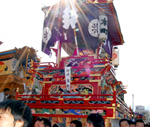
An Introduction to Saijo Matsuri
Saijo Matsuri is a grand festival held every October in the city of Saijo in Ehime Prefecture. In this harvest festival with over 300 years of tradition, enormous hand-carried floats called danjiri and mikoshi are presented to local shrines. There are more than 150 floats in the city.
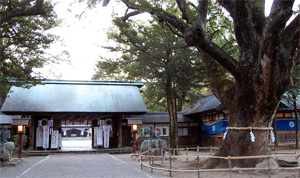
Isono Shrine
In addition to danjiri, mikoshi, and taikodai float parades, Saijo’s fall festival features many traditional Japanese attractions like shishimai (lion dance), yakko-gyoretsu (a dance parade performed in traditional costume), and kagura (ancient music and dance).
At the heart of these activities are the danjiri, great wooden floats standing approximately 5m tall and weighing 700kg. These structures are shaped like house frames and carried by 15-20 revelers during a two-day parade through the city to the beat of taiko drums, bells, and festival songs. Danjiri are typically named for the neighborhood that they represent.
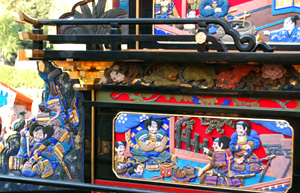 Danjiri floats are decorated with carvings depicting Japanese motifs, famous figures like Toyotomi Hideyoshi, and scenes from historical literature such as the Legend of Three Kingdoms. Some danjiri are also painted.
Danjiri floats are decorated with carvings depicting Japanese motifs, famous figures like Toyotomi Hideyoshi, and scenes from historical literature such as the Legend of Three Kingdoms. Some danjiri are also painted.
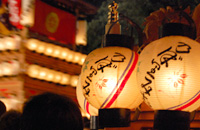
At night over 100 lanterns are affixed to each float, and the light from the candles creates an ethereal atmosphere completely different from the daytime. Watching Saijo Matsuri is like seeing a picture scroll unfurl and come to life before your eyes.
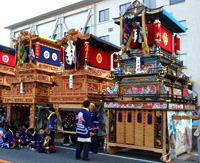 Danjiri |
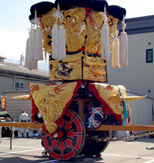 Mikoshi |
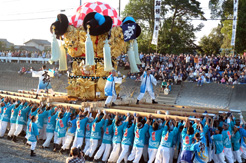 Taikodai |
The history of the danjiri
Danjiri is a general term for floats used in festivals, and in this region these floats are divided into two categories: danjiri and taikodai. Taikodai are used in the Iizumi Shrine Festival and in the autumn festival of neighboring Niihama City.
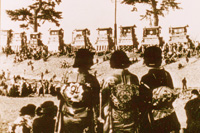 The origins of the danjiri in Saijo are historically unclear, but it is said that the head priest of Kichijo-ji Temple, which was associated with Iwaoka Shrine, saw the floats of a shrine in Kawachi Province (modern day Osaka Prefecture). Upon returning home, he decided to construct similar structures from bamboo and offer them to the shrine.
The origins of the danjiri in Saijo are historically unclear, but it is said that the head priest of Kichijo-ji Temple, which was associated with Iwaoka Shrine, saw the floats of a shrine in Kawachi Province (modern day Osaka Prefecture). Upon returning home, he decided to construct similar structures from bamboo and offer them to the shrine.
Saijo’s festival floats are first mentioned in official documents of Iwaoka Shrine in 1757 and in the records of Isono Shrine in 1761, and it is believed that danjiri existed during the Kan’en era (1748-51). Since then, danjiri have been newly constructed or renovated repeatedly all the way to the present day. Among these, some danjiri have been preserved for over 150 years and, due to their historical value, are designated important cultural properties by the city of Saijo. These floats are Koyashiki (1840), Himi Tera-no-shita (1855), Moto-uoyamachi (1862), Konyamachi (end of the Edo period), and Benzaiten (1864).

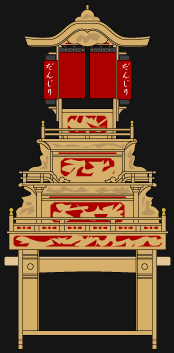
Danjiri Statistics
(all figures are approximate)
・Height 5.0m
・Length 3.2m
・Width 2.5m
・Weight 600~800kg
・1 taiko drummer
・1 bell player
・~20 carriers
Saijo Matsuri Schedule
・Iwaoka Shrine Festival Oct. 14-15
・Isono Shrine Festival Oct. 15-16
・Iizumi Shrine Festival Oct. 16-17
Other festival events occur across Saijo during this week.
Isono Shrine Festival schedule and recommended sightseeing spots
Early October-October 14 Preparations
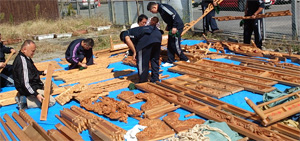 Assembling the danjiri
Assembling the danjiri
Each danjiri team’s members construct the large wooden floats. Keeping with traditional carpentry, the danjiri don’t use a single nail. The interlocking frame fits together like a great puzzle. The taiko drum and bell are lifted to the top level of the float and are often played by children. The sound of drum practice can be heard at night in the weeks leading up to the festival.
Many teams put together their danjiri on the Sunday closest to October 10th.
Teams take their completed danjiri out for practice runs around their respective neighborhoods, so it’s possible to see them before the festival starts.
Some danjiri are also presented at smaller shrines in their neighborhoods on this day, so you can see danjiri being put together and paraded around all over the city.
Oct. 14 Festival eve
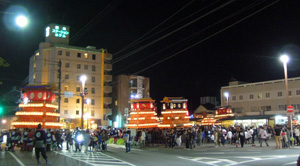
On the night before the festival starts, danjiri are carried around their respective neighborhoods.
The most spectacular displays take place around Iyo-Saijo Station and Saijo’s shopping arcade (shotengai). (around 6-9 p.m.)
Oct. 15 Miyadashi (the god leaves the shrine)
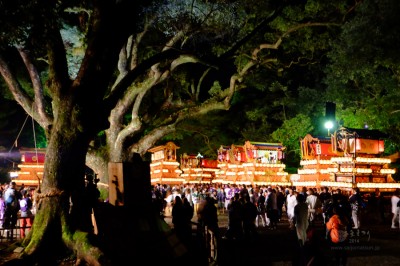 The danjiri gather at Isono Shrine from around 2 a.m. to greet the shrine’s god.
The danjiri gather at Isono Shrine from around 2 a.m. to greet the shrine’s god.
(The miyadashi ends at around 6 a.m.)
The floats depart from their neighborhoods between midnight and 3 a.m.
A long parade of danjiri illuminated by countless lanterns heading for Isono Shrine can be seen moving up Kitanocho Street.
Excitement for the festival reaches a fever pitch as the danjiri are carried up the steep stone steps in front of the shrine. (until around 6 a.m.)
Oct. 15 Danjiri roam the city
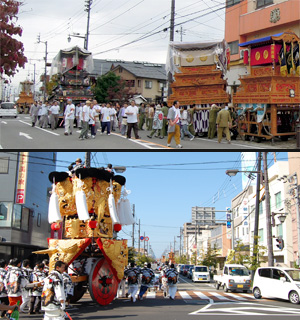 After the miyadashi, the danjiri are free to parade around the city. Many danjiri and mikoshi can be seen around the city center. (The danjiri parade until around 6 p.m.)
After the miyadashi, the danjiri are free to parade around the city. Many danjiri and mikoshi can be seen around the city center. (The danjiri parade until around 6 p.m.)
Danjiri parade in front of Iyo-Saijo Station, around Saijo’s shopping arcade (shotengai) and other locations, receiving donations and sake from citizens as part of the ohana-atsume tradition (lit. “flower-gathering”). Spirited encounters between danjiri and mikoshi (four special floats with enormous wheels) rambling about the city are an exciting part of the first day.
There are also scheduled gatherings of historically-connected danjiri and the four mikoshi at this time.
Oct. 16 Otabisho
From 1 a.m. the floats gather at Saijo Shrine in the Omachi neighborhood across the river from Isono Shrine to pay respect to the shrine god. Saijo Shrine is the otabisho, the place where the god rests for the evening of the first night. The procession that takes place here draws the god back out in its portable shrine for the second day of festivities.
As on the first night, the danjiri make their way up Kitanocho Street, crossing Route 11 in front of Minami Junior High School at the Joshin crosswalk.
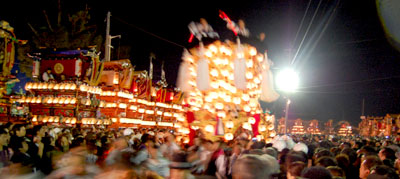
otabisho
After the nearly 80 danjiri have made their dedications to the shrines and lined up around the parade ground, the four mikoshi charge through the crowd to the shrine entrance.
The swaying lanterns that cover these two-wheeled mikoshi create a wave of golden light as they cut a wild path through the busy parade ground. The exciting second day of Saijo Matsuri can now commence. (The otabisho finishes at around 5 a.m.)
At 5 a.m. the danjiri begin an orderly parade from Saijo Shrine to the gates of Saijo High School.
Men wearing black clothes covered in white tassels known as “onigashira” (literally: demon head) *1 are responsible for maintaining order and keeping the festival on schedule. According to their Regulation Book *2 the course of the parade on the second day has been the same for many years.
Oct. 16 Gotenmae (Saijo High School)
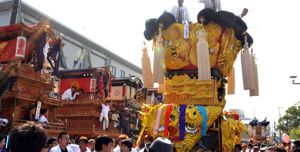 From 7-10 a.m. the danjiri are presented at the Gotenmae, the gate of Saijo High School. This is known as the sashiage*3. This beautifully preserved Edo period gate was once the entrance to the domain lord’s residence. The danjiri cross the narrow road spanning the large moat, their shimmering reflections displayed in the water as they pass one another.
From 7-10 a.m. the danjiri are presented at the Gotenmae, the gate of Saijo High School. This is known as the sashiage*3. This beautifully preserved Edo period gate was once the entrance to the domain lord’s residence. The danjiri cross the narrow road spanning the large moat, their shimmering reflections displayed in the water as they pass one another.
The danjiri then line up in numerical order as if surrounding the moat, and the mikoshi run through the crowd to the beat of their own taiko drums.
These mikoshi move with surprising speed, their white tassels waving and their overlay of willow and golden ropes reflected in the moat.
After the mikoshi parade, the shrine god arrives in the shinyo portable shrine *4 — accompanied by the attendant otomo-danjiri *5.
Oct. 16 – Tamatsu

The danjiri line up along the Murokawa River as the three danjiri of the Tamatsu neighborhood gather on the bridge to present themselves.
Oct. 16 Miyairi (the god returns to the shrine)
The shinyo crosses the Kamogawa River.
The danjiri enter the river as the climax of the festival. (4-6 p.m.)
All 65 danjiri from neighborhoods on one side of the river line up on the bank. The 11 danjiri from the Isono Shrine side of the river (the Kanbe neighborhood) cross the bridge and line up on the opposite bank. The god in its shinyo departs from the Honmachi otomo-danjiri, its attendant float for the second day, and enters the river. The Kanbe danjiri also rush into the river to greet the god as it crosses back to Isono Shrine.
The festival ends once the shinyo has reached the opposite shore. The danjiri disperse as if dejected by the departure of the god, a powerful and emotional close.

Ohoribata・Oct. 16 The Night After
 After the festival has ended, the danjiri return to their neighborhoods.
After the festival has ended, the danjiri return to their neighborhoods.
Not wanting the festivities to end, many danjiri gather in front of Iyo-Saijo Station, at the moat surrounding Saijo High School, and other places across the city. (7-9 p.m.)
In recent years, it has become popular for danjiri and mikoshi to display their lanterns in the moat (ohoribata) surrounding Saijo High School, creating one final, beautiful image for participants and spectators.
– Notes –
*1 The Onigashira are members of the Isono Shrine Onigashira Association, which are the organizers of this festival.
*2 The Regulation Book sets forth parade order and other rules. It was published by the Onigashira Association in 2000.
*3 Most danjiri rest on wheels hidden beneath the frames that aid the carriers, but when the danjiri are presented at the Gotenmae and the shrines, they are lifted from these wheels and supported totally on the shoulders of the carriers. Many danjiri are lifted completely above the carriers’ heads. Maintaining balance during this dangerous operation requires a high level of skill by the carriers. (Don’t forget to give these brave revelers a round of applause.)Sashiage
*4 The shinyo houses the god of Isono Shrine.
*5 The Honmachi danjiri, also known as the otomo-danjiri, accompanies the shinyo across the city and does not participate in the parade. It is the only unnumbered danjiri.Otomo



